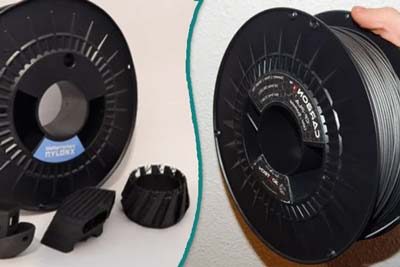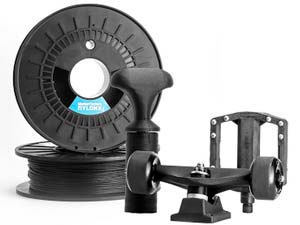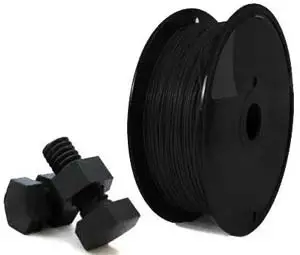
3D printing has soared to sky-high popularity in recent years. From being the latest scientific wonder, it has now become easily available to the masses and a common choice for interesting DIY projects.
As a result, many commercial brands have popped up to cater to the 3D printing enthusiasts. They have put out a wide range of impressive filaments for getting the most out of it.
Although different kinds of plastic have always been people’s favorite, carbon fiber filaments like CarbonX and NylonX are also in demand.
But which one of them is the right choice for you? Let’s find out the strength and weaknesses of both these filaments in our NylonX vs CarbonX discussion!
What is NylonX?
NylonX is simply a modified version of the nylon fiber manufactured by MatterHackers for 3D printing. It belongs to their PRO Series of 3D printer filaments.
This particular filament is created by reinforcing its original material (nylon) with micro-carbon fibers. As a result, the produced threads become stronger which is necessary for building sturdy models with 3D printing.
Along with better stiffness, the NylonX filaments also offer higher resistance and tensile strength for the end product. It essentially brings you the best of both worlds by combining the rigidity of carbon fiber and the durability of nylon.
Advantages of NylonX
Strength
NylonX is built for industry-standard engineering jobs that require a certain level of robustness. Since 20% of this filament includes chipped carbon fibers, it provides impressive strength to each 3D printed model. The resulting structure will be safe from shattering and perform more functionally than the alternatives.
Durability
As we previously mentioned, NylonX has the durability of nylon without most of its pitfalls. Any object made with it will surely last a long time and stay safe from the most common accidents because of its persistent tolerance.
Matterhackers tested the stress limits of all their filaments using force gauge and a pulley system. They found out that NylonX is their second most resilient filament right behind polycarbonate! It can withstand up to 408 lbs. at a peak, 281 lbs. at the lowest and 364 lbs. on average which are highly impressive numbers.
Saves Time
If you need a filament that will help you speed up daily projects and enable you to satisfy more clients per day, NylonX can be a great companion. It doesn’t require any post-processing steps like polishing, sanding or scraping. As a result, you can move the printed 3D structure to production as soon as it is completed.
Disadvantages of NylonX
Highly Hygroscopic
The word hygroscopic is used to describe objects or materials which soak in moisture from surrounding air. Unfortunately, the hygroscopic nature of NylonX can lead to printing issues and therefore, spoiled results. So make sure that the filament is absolutely dry each time before using it in the 3D printer.
Read our related article on How to Dry Out PETG Filament for instructions, tips, and different methods.
Stringing and Warping
Even though NylonX does a great job of instilling more rigidity and stability than the original nylon fiber, it can still lead to a bit of warping and stringing in the end product. NylonX does not work well with some nozzles which causes the filament to ooze out and land in problematic areas
Highly Abrasive
Speaking of nozzles, remember to never use NylonX filaments through brass nozzles. It has carbon fiber which is highly abrasive. As a result, it can rub against the soft metal nozzles and damage them enough to produce erroneous models. That is why go for hardened nozzles made of stainless steel for NylonX.
What is CarbonX?
CarbonX is one of the newest additions to the list of 3D printer filaments. Similar to NylonX, this filament is made by instilling carbon fiber into the original material. As a result, you can rely on it for impressive sturdiness, dimensional stability, high heat and surface quality.
It is usually manufactured by 3DXtech – a brand dedicated to delivering 3D printing filaments and accessories. They have developed many versions of CarbonX by experimenting on different popular 3D printing materials as the base. You will find ABS, PPA, PLA, PC, PEI, PEEK,PETG, PEKK and Nylon among them.
These filaments are usually available in two diameters of 1.75mm and 2.85mm. You can get them in an amount of 1.65 lbs or 4.4 lbs according to your individual project requirements.
Advantages of CarbonX
Free From Warping And Cracking
A huge advantage that CarbonX has over most other 3D printing filaments is its immunity against warping and cracking. You can pretty much guarantee a flawless structure at the end of each printing session with CarbonX. Its carbon fiber content provides impressive dimensional stability.
No Heated Bed Required
If your 3D printer has no heated bed or temporarily lacks it, you can continue building figures with that printer using CarbonX.
This filament does not depend on a heated bed to perform. You can, of course, add it for a better result but it is not absolutely necessary.
Thermal Performance
CarbonX is capable of exceptional temperature resistance. The carbon fiber content of this filament gives it a high modulus and HDT (Heat Deflection or Distortion Temperature). This along with its advanced extrusion and compounding technology resists well against potential deformation.
Affordable
Compared to similar filaments infused with carbon fiber, CarbonX comes at an affordable price point. You will get a little extra in quantity here than others without spending extra!
Such affordable pricing should make things easier for the hobbyists out there who are just starting out in 3D printing.
Read More: Recommended Bed Temperature for PLA. Here’s the temp you want your print bed to be when using PLA!
Disadvantages of CarbonX
Post-processing
You may often find yourself in post-processing tasks to get the perfect 3D printed models of CarbonX. Certain delicate parts like overhangs can exhibit stringing and similar common inconsistencies. They will require sanding or further tuning in the slicing stage.
Weak Parts
CarbonX may not be the best option when it comes to creating sturdy elements. The layers may not stick to each other well enough because of the extruded filaments.
Therefore, the resulting objects can seem weaker. You can easily gloss over this drawback by reducing the printing speed and increasing its temperature.
Abrasive
Because of the presence of carbon fiber, CarbonX filaments are abrasive in nature. So if you make it work with soft metal nozzles like brass, the filaments will reduce its durability and put it out of service quite quickly.
That is why remember to use hardened steel nozzles instead every time you print a 3D structure with CarbonX.
Comparing CarbonX VS NylonX

Uses
The upgraded version of typical nylon fiber – NylonX can be used in projects where the printed structure needs to be strong and long-lasting. Usually, this filament is used to build gears, drone parts, sports accessories, race cars and home furnishing fittings.
Besides, you can always use it to create artistic masterpieces of complex designs. Its unique and natural matte black color will bring elegance to your finished project.
On the other hand, CarbonX is typically used for high layer heights and widths. We recommend it to not use for making thin walls. You can use it in any project of simple shapes where strength, stiffness and safety from warping are significant factors.
Post-processing
A major advantage of choosing NylonX over CarbonX is that you don’t have to worry about post-processing steps anymore. While the perfectionists can spend time on these steps, you can actually get away with no polishing, sanding or scraping!
The same can’t be said about CarbonX. You need to arrange for processes like sanding and other tuning mechanisms to get a flawless outcome after using this filament.
Technical Requirements
Both of the filaments are abrasive in nature. So you cannot use brass nozzles with either of them. You must have a hardened nozzle made of stainless steel or like Olsson Ruby in place while working with them.
Like most 3D printer filaments, NylonX needs heated bed to perform. However, CarbonX can do its job without the bed. The recommended bed temperature range is 60°C to 65°C for NylonX and 23°C to 60°C for CarbonX.
Size
You can find both the filaments in the diameter of 1.75mm. Additionally, NylonX also comes in the size of 3mm diameters while CarbonX offers a diameter of 2.85mm. Both of them provide a beautiful pristine matte black finish to the end product. So all you have to decide on is the required diameter.
Cost
NylonX is slightly more affordable than CarbonX. While both of them are available at price points way below a hundred dollars, the amount provided at that cost is where they differ. You can get 500 grams of NylonX and 750 grams of CarbonX at the same price! So you can choose the latter if the budget is limited.
Bottom Line – Which One is For You?
In the end, there is no clear choice in the NylonX vs CarbonX comparison. Both of them a considerable number of benefits and limitations. You will need to get stainless steel or Olsson Ruby nozzles for working with either one.
If you want to say goodbye to post-processing tasks and prefer larger diameters, choose NylonX. For more variations of the base material, safety from thermal deformations and higher affordability, go for CarbonX. It all depends on what your particular project needs.
Our Other 3D Related Articles Bellow:

